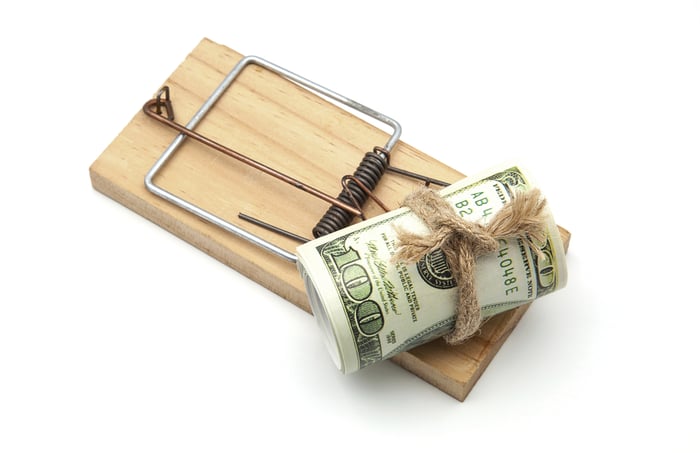TDV vs. TDIV: Talking Tech Dividends With ETFs
The technology sector is a surprising source of dividend growth, and these ETFs have the tech payout goods.
Many investors don’t readily think of dividends and tech together, but there’s more than meets the eye with this union.
Talk to enough experienced dividend investors and chances are they’ll rattle off sectors like consumer staples, healthcare and utilities as some of their favorite payout destinations. Odds are equally good that they won’t mention technology.
That’s understandable, because the 12-month distribution rate on the largest exchange traded fund (ETF) tracking the tech-heavy Nasdaq-100 Index is a piddly 0.48%Obviously nothing to write home about, but that data point obfuscates tech’s status as a rising payout growth spot. In fact, in dollar terms, Microsoft (MSFT 0.78%) and Apple (AAPL 0.42%) are two of the biggest dividend payers in the S&P 500.

Image source: Getty Images
Apple and Microsoft are widely held stocks, but in what amounts to a pleasant surprise for equity income investors, the duo is an appetizer in the tech dividend equation. Seven-course meals are available with the First Trust NASDAQ Technology Dividend Index Fund (TDIV 0.79%) and the ProShares S&P Technology Dividend Aristocrats ETF (TDV 0.81%).
Similar tickers, but different methodologies. So, let’s examine how these ETFs live up to their tech dividend billings.
TDV: A familiar playbook
As its name implies, the ProShares S&P Technology Dividend Aristocrats ETF has Dividend Aristocrats DNA. The TDV follows the S&P Technology Dividend Aristocrats – a collection of tech companies that have increased payouts for at least seven straight years.
With tech and dividends still considered newlyweds, that index requirement sounds confining, but TDV holds 38 stocks. That roster size is aided by index flexibility that allows for “tech-related” companies. Mastercard (MA 0.42%) and Visa (V 1.39%) being prime examples.
If there’s a rub with TDV’s plumbing, it’s that the dividend increase streak requirement precludes some big names from entering the index. For example, Alphabet (GOOG -0.98%) and Nvidia (NVDA 0.24%) are dividend payers, but they haven’t increased payouts for seven straight years, so they’re not yet candidates for TDV admission.
TDV has points in its favor, including equally weighting its holdings. That means the ETF can be an income-generating complement to stakes in tech funds that weigh components by market capitalization – many of which have rosters where a small number of stocks command whopping percentages of the portfolios.
TDIV: Tech dividend flexibility
While TDV’s dividend increase streak mandate has a country club membership feel to it, the First Trust NASDAQ Technology Dividend Index Fund has its own elements of exclusivity. The fund follows the Nasdaq Technology Dividend™ Index, which has several rules dividend investors need to acknowledge. Those include requiring member firms to have paid a dividend over the past year, no payout cuts over that time and a minimum yield of 0.50%.
By eschewing the payout increase streak protocol, TDIV sports a significantly larger roster than its rival – 94 holdings to be precise. There’s another big difference between the tech dividend ETFs. TDIV holdings are dividend value-weighted. In plain English, the ETF’s index places added emphasis on stocks with big dividends and massive market caps. Hence, Broadcom (AVGO 0.88%), Oracle (ORCL 0.84%) and Microsoft combine for nearly a quarter of the ETF’s weight. TDIV has a different way of doing things, but it’s hard to argue with its performance since inception in August 2012.
There are other marquee differences between TDIV and its nearest competitor. Notably, the First Trust ETF can hold international stocks, some of which have been additive to performance, and 20% of its portfolio can be allocated to communication services stocks. The latter point is pertinent because if Alphabet and Meta Platforms (META -1.08%) increase their payouts enough to drive their yields to 0.50%, those stocks would be eligible for TDIV admittance, perhaps increasing the ETF’s growth profile along the way.
Different tech dividend strokes for different folks
For fee-conscious investors, TDV is an appealing option because its annual expense ratio is 0.45%, or $45 on a $10,000 position, compared to TDIV’s 0.50%, but fee tussles aren’t the end ETF comparisons. Smart investors know there’s more to the story.
The ProShares ETF may be more appropriate for investors seeking documented dividend dependability via an instrument that as currently constructed, leans into mature, older guard technology companies. Plus, the fund’s equal-weight methodology may be attractive at a time when so many cap-weighted indexes are heavily concentrated in a small number of stocks.
On the other hand, TDIV is perhaps the better choice for growth investors that want a dash of income. Past performance isn’t a guarantee of future returns, but it shouldn’t be ignored that over the past three years, TDIV’s returns and volatility traits stacked up well against some traditional tech ETFs, indicating its flexibility and index mechanics play in investors’ favor.
The Motley Fool has positions in and recommends Alphabet, Apple, Mastercard, Meta Platforms, Microsoft, Nvidia, Oracle, and Visa. The Motley Fool recommends Broadcom and recommends the following options: long January 2026 $395 calls on Microsoft and short January 2026 $405 calls on Microsoft. The Motley Fool has a disclosure policy. Todd Shriber owns shares of Alphabet and Broadcom.


